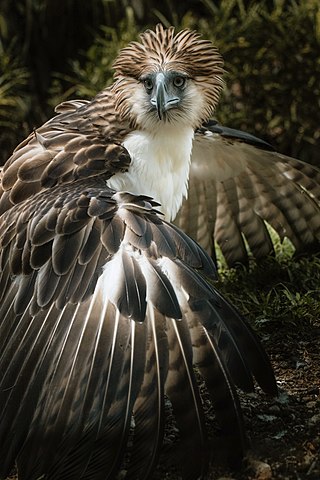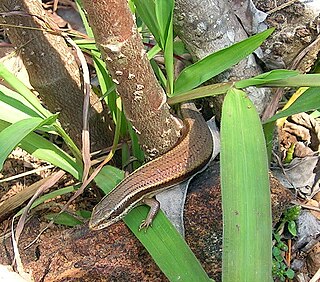
The Philippine eagle, also known as the monkey-eating eagle or great Philippine eagle, is a critically endangered species of eagle of the family Accipitridae which is endemic to forests in the Philippines. It has brown and white-colored plumage, a shaggy crest, and generally measures 86 to 102 cm in length and weighs 4.04 to 8.0 kg.

Anomochilidae is a family of snakes with one genus, Anomochilus, containing three species of snake. Members of the genus are known as anomochilids, or by the common names dwarf pipesnake, lesser pipesnake, and giant blind snake. Initially created as Anomalochilus in 1890 for the species A. weberi, the genus was renamed in 1901 because the original name was already in use for a genus of beetles. Dwarf pipesnakes are small and cylindrical, with short, conical tails and small, rounded heads that are continuous with the neck. They have blackish to purplish-brown uppersides and dark brown or black undersides, with orange-red bands around the tail and a variety of pale markings on the snout and belly. All three species of dwarf pipesnake are endemic to Sundaland, where they are found on the Malay Peninsula and the islands of Sumatra and Borneo.

The Philippine scops owl is a common owl, endemic to the Philippines, belonging to the family of the typical owls Strigidae. Other common names include "Otus Whitehead", "Whitehead scops owl" and "Luzon lowland scops owl". Everett's scops owl and Negros scops owls were formerly considered conspecific but are now classified as separate species.

Siebenrockiella leytensis is a species of freshwater turtle endemic to the Philippines. It is classified as critically endangered. It is known as the Philippine forest turtle, the Philippine pond turtle, the Palawan turtle, or the Leyte pond turtle. Despite the latter common name, it does not occur in the island of Leyte but is instead native to the Palawan island group. It is locally known as bakoko in Cuyonon.

The Philippine warty pig is one of four known species in the pig genus (Sus) endemic to the Philippines. They have tufts of hair on the top of their head and on the lower sides of their jaws, as well as four warts on their faces. Their skulls are elongated; males have tusks and bigger skulls than females, an example of sexual dimorphism. They are considered Vulnerable by the IUCN, and their population is currently declining due to multiple threats. The pigs are probably nocturnal.

Calamaria is a large genus of dwarf burrowing snakes of the family Colubridae. The genus contains 66 recognized species. The genus is endemic to Asia.

The Philippine oriole or grey-throated oriole is a species of bird in the family Oriolidae. It is endemic to the Philippines.

The harpy fruit bat is a species of megabat in the family Pteropodidae. It is endemic to the Philippines.

Lygosominae is the largest subfamily of skinks in the family Scincidae. The subfamily can be divided into a number of genus groups. If the rarely used taxonomic rank of infrafamily is employed, the genus groups would be designated as such, but such a move would require a formal description according to the ICZN standards.
Acutotyphlops banaorum is a species of snake in the family Typhlopidae. The species is endemic to the Philippines.

Calamaria gervaisii, commonly known as Gervais's worm snake and the Philippine dwarf snake, is a species of small fossorial snake in the family Colubridae. The species is native to the Philippines.

Boiga schultzei, commonly known as the Schultze's blunt-headed tree snake, is a species of snake in the family Colubridae. The species is endemic to the Philippines.

Cyclocoridae is a family of elapoid snakes endemic to the Philippines.
Calliophis salitan is a species of venomous snake in the family Elapidae. It is endemic to the Philippines and known from Dinagat Island and Mindanao; the former is based on a small number of recent records whereas the latter is based on a museum specimen from 1887.

Oxyrhabdium modestum, commonly known as the Philippine shrub snake, is a species of snake in the family Cyclocoridae. It is found the Philippines on the islands of Basilan, Bohol, Dinagat, Leyte, Mindanao, Negros and Samar.

The Elapoidea are a superfamily of snakes in the clade Colubroides, traditionally comprising the families Lamprophiidae and Elapidae. Advanced genomic sequence studies, however, have found lamprophiids to be paraphyletic in respect to elapids, and anywhere between four and nine families are now recognized.

Alocasia zebrina, commonly known as the zebra plant or zebrina alocasia, is a plant in the family Araceae. It is endemic to the islands of Luzon, Mindanao, Leyte, Samar, Biliran, and Alabat in the Philippines. It is commonly grown as an ornamental plant worldwide. It is also locally known as gabing tigre in Tagalog. It is nationally listed as a threatened species and collection of A. zebrina from the wild is illegal in the Philippines.
Myersophis is a genus of snake in the family Cyclocoridae. It contains only one species, Myersophis alpestris or Myers's mountain snake, which is endemic to the Philippines.
Calamaria alcalai, Alcala's reed snake, is a species of snake in the family, Colubridae. It is endemic to Mindoro, the Philippines.
Oligodon maculatus, the spotted kukri snake, is a species of snakes in the subfamily Colubrinae. It is found in the Philippines.















